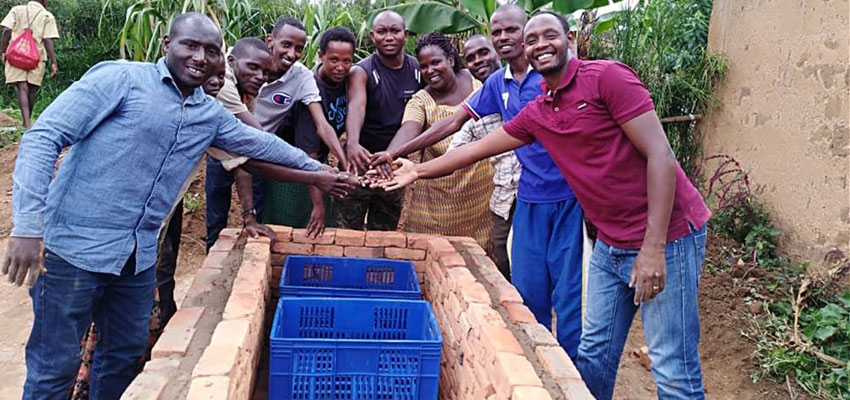

Research Report
![]() Evaporative Cooling for Improved Fruit & Vegetable Storage in Rwanda & Burkina Faso
Evaporative Cooling for Improved Fruit & Vegetable Storage in Rwanda & Burkina Faso
Appendix
![]() Evaporative Cooling for Improved Fruit & Vegetable Storage in Rwanda & Burkina Faso
Evaporative Cooling for Improved Fruit & Vegetable Storage in Rwanda & Burkina Faso
Executive Summary
The horticulture sector plays a vital role in supporting human nutrition and income generation for farmers in Rwanda and Burkina Faso. A lack of affordable and effective postharvest fruit and vegetable storage solutions often leads to spoilage, loss of income, reduced access to nutritious foods, and significant amounts of time spent traveling to sell and purchase fresh produce (fruits and vegetables), particularly in rural communities. Studies conducted in Rwanda and Burkina Faso indicate that postharvest losses for perishable products like tomatoes are between 50-60%.
The objective of this research study is to investigate the potential for non-electric evaporative cooling devices to address challenges of postharvest fruit and vegetable storage in Rwanda and Burkina Faso. The two classes of devices evaluated in this study are commonly known as “Zero Energy Cooling Chambers” (ZECCs), which are generally used by horticulture farmers, farmer groups and cooperatives, and “clay pot coolers,” which are generally used in households. These devices rely on the evaporation of water to create a cooling effect, and their performance is significantly affected by the ambient temperature and humidity of the environment in which they operate.
In this study, we used a combination of electronic sensors, fruit and vegetable shelf life measurements, and structured user interviews to gather information about users’ needs for improved postharvest storage, current methods of postharvest storage, and the performance of the evaporative cooling devices.

Insights
The results of this research indicate that evaporative cooling devices can provide value across a range of environmental conditions and fruit and vegetable types, and uncovered the following insights in Rwanda and Burkina Faso.
Promising Results
- The devices provide increased humidity, decreased daily average temperatures, decreased peak daily temperatures, and improved temperature stability, all of which can lead to improved vegetable shelf life. All of the devices provide a minimum of the following benefits:
- An average interior humidity greater than 95%, which reduces dehydration and improves shelf-life.
- A decrease in the average daily temperature between 1 and 3 C.
- A reduction in daily temperature fluctuations from 10 – 20 C each day to less than 4 C throughout a given day. It is important to note that even when there is not a significant decrease in the average temperature, it is beneficial to store produce in an environment with a stable temperature.
- The peak daily temperature is reduced by 7 – 15 C, and avoidance of peak temperatures above 30 C.
- In Burkina Faso the clay pot in clay pot cooler design provided a larger decrease (8 C) in the average temperature than designs with a clay pot in a dish or a plastic container in a clay pot (4 – 5 C).
- Farmers using brick ZECCs in Rwanda reported shelf life improvements ranging from 2 to 4 times for specific vegetables compared to the shelf life in ambient conditions.
- Fruit and vegetable vendors are suffering significant financial losses due to spoilage and can benefit from evaporative cooling devices.
Barriers and Constraints to Evaporative Cooling Technology Adoption
- The high humidity in Rwanda (during the research period) limits the temperature decrease that can be achieved.
- Fungal contamination from the sides of inner clay surfaces or spreading of rot from one fruit and vegetable type to another, can accelerate deterioration. Plastic or metal inner containers may be used to avoid this issue.
- Cost of construction of ZECC and acquisition of crates is a barrier for many potential users studied.
- As the ZECC is a temporary structure, there is risk of the ZECC falling apart especially because of heavy rain.
- Organizing the construction, use, and security of shared ZECCs requires planning and coordination.
Recommendations for Scale-up
In addition to recommendations for construction, use, and dissemination that have been outlined elsewhere (Evaporative Cooling Best Practices Guide), the following recommendations were generated based on the results of this research study:
- Connect potential users with existing users of evaporative cooling devices to share advice on construction, and use, and cost of these devices.
- In addition to households and farmers, specifically, target the dissemination of evaporative cooling devices (ZECCs and clay pot coolers) to fruit and vegetable vendors and markets with permanent structures who suffer financial losses due to spoilage.


For more information
Evaporative Cooling for Vegetable Preservation
Contact
Eric Verploegen, MIT D-Lab Research Engineer, Food-Water-Energy Lead

